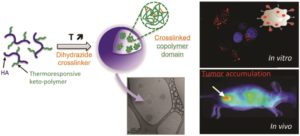The pharmacokinetics and pharmacodynamics of any drug or nanoparticles plays an important role towards the therapeutic activity, half-life of the therapeutic agent and frequency of dosing of the biomaterial in various diseases. Recently, the development of biopolymer nanogels has received tremendous attention due to their effective delivery of therapeutics, size uniformity, high drug encapsulation capacity, easy preparation, high biocompatibility and size tunability. However, the tendency of these nanogels to disassemble in the bloodstream is cause for concern, due to the interactions with serum proteins and excessive dilution volume that decreases the tumor targeting efficiency through EPR effects. In this regard, substantial research is needed to develop novel platform technologies for bioactive nanogels with enhanced bioavailability.
In this work, Auzély-Velty and co-workers, developed a novel and easy method to synthesize stable self-assembled hyaluronic acid (HA) nanogels, modified with a thermoresponsive ketone-functional copolymer by hydrazone formation. The cross-linking density played a crucial role in the nanogel stability and pharmacokinetics, and it was easily tuned by varying dihydrazide crosslinker to ketone ratio. Several physicochemical characterizations including cryo-transmission, dynamic light scattering and scanning electron microscopy were performed to analyze the size, morphology and stability of the nanogels. The authors showed the in vitro cellular uptake of the nanogels by CD44 receptor mediated pathway further confirmed the effectiveness of the cross-linking strategy. The modified nanogels demonstrated superior bioavailability in tumors, with enhanced blood circulation for over 24 hours, demonstrated in vivo in biodistribution studies with mouse tumor models. Overall, these nanogels are inexpensive, stable, easily tunable and biocompatible, thus holding promise for the discovery of a new class of molecules for cancer therapy application in near future.
This article is free to read and download until 13th August.
A versatile method for the selective core-crosslinking of hyaluronic acid nanogels via ketone-hydrazide chemistry: from chemical characterization to in vivo biodistribution Biomater. Sci., 2018, 6, 1754-1763
About the web writer
 Dr. Sudip Mukherjee is a Web Writer for Biomaterials Science. He is currently a Postdoctoral Research Associate at the Rice University. His research is involved in the development of advanced nanomaterials for drug/gene delivery in cancer theranostics, immunomodulatory applications & angiogenesis. He published a total of ~35 research articles/patents. He serves as International Advisory Board Member for ‘Materials Research Express‘, IOP Sciences. He is an associate member (AMRSC) of RSC, UK. He serves as reviewer for several international journals like ChemComm, J Mater Chem A, J Mater Chem B, Journal of Biomedical Nanotechnology, RSC Advances, IOP Nanotechnology, Biofabrication etc.
Dr. Sudip Mukherjee is a Web Writer for Biomaterials Science. He is currently a Postdoctoral Research Associate at the Rice University. His research is involved in the development of advanced nanomaterials for drug/gene delivery in cancer theranostics, immunomodulatory applications & angiogenesis. He published a total of ~35 research articles/patents. He serves as International Advisory Board Member for ‘Materials Research Express‘, IOP Sciences. He is an associate member (AMRSC) of RSC, UK. He serves as reviewer for several international journals like ChemComm, J Mater Chem A, J Mater Chem B, Journal of Biomedical Nanotechnology, RSC Advances, IOP Nanotechnology, Biofabrication etc.
Contact Email: sudip.mukherjee@rice.edu
Twitter: https://twitter.com/sudip_88











